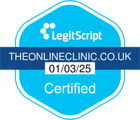Perioral Dermatitis
What is Perioral Dermatitis?
Perioral dermatitis (sometimes called periorificial dermatitis) is a skin condition. It appears as a skin rash that consists of small red lumps on the surface of the skin around the mouth. Perioral dermatitis may also affect the skin around the nose or eyes. The condition usually resolves with treatment or after determining the cause, although this may take weeks to months, and it can return. Perioral dermatitis is not contagious.
Getting treatment for Perioral Dermatitis
The Online Clinic can diagnose Perioral Dermatitis from a photo during an online consultation. Please commence a free consultation to get started. Private prescriptions are available from as low as £29.95.
Who gets Perioral Dermatitis?
Perioral dermatitis is thought to occur in 0.5%–1% of the population in developed countries, including Western Europe and the USA. The condition typically affects young adult females, and about 90% of affected cases are women aged 15–45 years. Perioral dermatitis is not often seen in men, although the number is increasing due to more men choosing to use skin products on their face. It may also occur in children, with no particular difference between the sexes or races.
What causes Perioral Dermatitis?
The reason why perioral dermatitis occurs is unknown. However, it is thought to involve a problem with the functioning of the skin’s protective barrier, as an increase in water loss though the skin is reported.
Most evidence points to the use of corticosteroids on the skin surface, and the potential to overuse this topical medicine. Topical corticosteroids are often used on the face for another skin condition before the perioral rash appears. Sometimes, the rash appears when a topical corticosteroid was used on another area of the body, because hands were not washed before touching the face. Once the rash appears, it can temporarily improve with a topical corticosteroid. However, when the treatment is stopped (particularly if suddenly), the rash returns and is usually worse. A continuous cycle may begin, whereby more corticosteroid is used, the rash clears, the corticosteroid is stopped, and the rash returns getting worse every time. Perioral dermatitis may also occur following nasal or inhaled corticosteroid use.
Perioral dermatitis has been associated with some cosmetics as well as other skin care products. It seems that the skin of some people is triggered by certain ingredients. For example, paraffin- or petrolatum-based creams and ointments, use of a combination of foundation, moisturisers, and night creams; sunscreens with a high sun protection factor used on the face; and fluorinated toothpaste.
Several other factors have been connected with perioral dermatitis. Micro-organisms that often live on human skin (e.g., the yeast Candida, and rod-shaped bacteria), and within hair follicles (the mite Demodex) can act as triggers. Physical factors, including UV light, strong wind, and heat (due to exercise) may worsen the condition. Hormonal factors have also been suggested to worsen the condition in women who are premenstrual (just before their period), pregnant, and are using oral contraceptives.
Who is at risk of Perioral Dermatitis?
There appears to be two main risk factors: adult females aged 15–45 years, and people using topical corticosteroids on the face.
What are the signs and symptoms of Perioral Dermatitis?
Typically, there is a skin rash that consists of small red lumps with a red base, which may have whitish or yellowish pus-filled tops. Occasionally, the skin becomes dry and scaly. The skin rash may cause a sensation of mild burning, although typically, the rash is neither itchy or painful. The skin rash surrounds the mouth. Often, there is a small gap between the edge of the lips and the rash. However, perioral dermatitis may also affect the skin around the nose or eyes.
The rash tends to vary in severity, from a few unnoticeable groups of small red lumps to an unsightly area of rash. In more severe cases, the groups of small red lumps may merge together. At worst, the condition can leave scarring. Perioral dermatitis can be emotionally distressing, and reduce the quality of life of the individual.
How is Perioral Dermatitis diagnosed?
A diagnosis of perioral dermatitis is made by a doctor, based on the appearance of the skin. No further tests are usually required, and only very rarely a skin biopsy (where a small piece of skin is taken) is needed.
Perioral dermatitis can be incorrectly identified as acne vulgaris (spots or pimples), rosacea (facial flushing and redness, with spots), and contact dermatitis (a rash appearing on contact with a substance).
How is Perioral Dermatitis treated?
Many cases of perioral dermatitis last for a limited time period only and will resolve without treatment. However, left untreated, other cases can take many months to clear. Usually, a dermatologist is needed to determine agents causing or worsening the condition, and provide the right treatment for the individual. Typically, medication depends on the skin’s appearance, and severity and duration of the condition. The time it takes for the prescribed treatment to work and the condition to clear up, could be weeks or months.
Treatment does not involve the use of topical corticosteroids, and they should be stopped completely if being used. Discontinuing topical corticosteroids can lead to worsening of the condition, particularly if treatment is stopped abruptly. Where the topical corticosteroid was of medium or high strength, and/or had been used for a long time, a low strength topical corticosteroid such as hydrocortisone may be used before stopping. Sometimes, this means that a low strength topical corticosteroid is used for a short time along with the appropriate treatment.
Antibiotics can be helpful as they can reduce inflammation. Mild cases of perioral dermatitis may be treated with a topical preparation, such as erythromycin or clindamycin, formulated in a cream, gel or lotion. If topical antibiotics are inappropriate, such as where the rash covers large areas of skin or have been ineffective, then an oral antibiotic such as a tetracycline or erythromycin can be prescribed. These antibiotics reduce the time taken for the condition to resolve. Both topical and oral antibiotics may be used together. Oral antibiotics tend to work more quickly but are used for a shorter time, while topical antibiotics may take weeks or months to be fully effective, and can be used for longer.
Topical calcineurin inhibitors such as pimecrolimus cream can also be effective in treating perioral dermatitis. These medicines reduce inflammation and therefore the severity of the condition, particularly when the cause is through use of topical corticosteroids.
How can a person with Perioral Dermatitis help themselves?
An affected person can help
- Use only those skin medicines prescribed by a doctor.
- Discontinue use of topical steroids, while acknowledging that the rash may get worse before it gets better.
- Also discontinue using products on the skin (e.g., cosmetics, skin care products, and fluoride toothpaste) that may be causing or worsening the condition. (Seek medical advice before stopping any medicines prescribed for use on the face).
- The rash should be gently washed with warm water only and patted (not rubbed) dry.
- Mild fragrance-free products only should be used for skin care.
- Only use cosmetics and other products permitted by a dermatologist on the affected skin areas, at least until the condition has resolved. However, because the rash can reoccur, using of other skin care products on previously affected facial skin may not be advisable.
- Wash hands before touching the face or before using topical medicines or permitted skin care products on the face, as well as after applying topical corticosteroids to other areas of the body or on someone else.
References
American Academy of Dermatology. The red rash around your mouth could be perioral dermatitis.
Available at: https://www.aad.org/public/diseases/a-z/perioral-dermatitis
Hall CS, Reichenberg J. Evidence based review of perioral dermatitis therapy. G Ital Dermatol Venereol. 2010;145(4):433–444.
Kammler HJ. Perioral Dermatitis Treatment & Management. Medscape 13 November 2020.
Available from: https://emedicine.medscape.com/article/1071128-overview#a4
Malik R, Quirk CJ. Topical applications and perioral dermatitis. Australas J Dermatol. 2000;41(1):34–38. doi: 10.1046/j.1440-0960.2000.00385.x.
Schwarz T, Kreiselmaier I, Bieber T, Thaci D, Simon JC, Meurer M, Werfel T, Zuberbier T, Luger TA, Wollenberg A, Bräutigam M. A randomized, double-blind, vehicle-controlled study of 1% pimecrolimus cream in adult patients with perioral dermatitis. J Am Acad Dermatol. 2008;59(1):34–40. doi: 10.1016/j.jaad.2008.03.043.
Tolaymat L, Hall MR. Perioral Dermatitis. [Updated 2023 Apr 17]. In: StatPearls [Internet]. Treasure Island (FL): StatPearls Publishing; 2023 Jan-.
Available at: https://www.ncbi.nlm.nih.gov/books/NBK525968/
GMC registration number: 4524038

Date: 30 October 2023
Next review: 29 October 2025
All UK registered doctors can have their registration checked on
The Medical Register at the GMC website.
Skin and Nails News
NICE Examines New Psoriasis Treatment
NICE Begins Approval Process for New Treatment for Severe Psoriasis Draft guidelines that back the use of Almirall’s new product Skilarence, for the treatment of moderate or severe plaque psoriasis by the National Health Service in the United Kingdom, have been issued by the National Institute…
Read full article >Duac Gel in Stock
After being out of stock for a while owing to a manufacturing problem, we are pleased to report that Duac Once Daily Gel is back in stock. Duac is a popular prescription acne treatment that contains Benzoyl Peroxide and Clindamycin. If you have already been approved for this product through our…
Read full article >Trimovate Finally Back in Stock
We are delighted to announce that Trimovate is back in stock and available for next day delivery. This product is an almost indispensable medication, so it is good to have it back in stock after a manufacturing problem that has gone on for well over a year. Trimovate is one of the few products…
Read full article >







